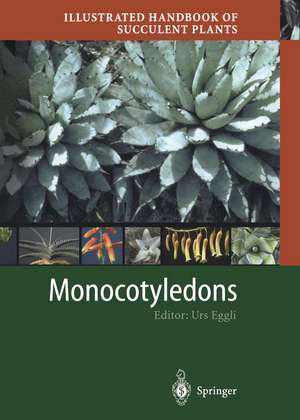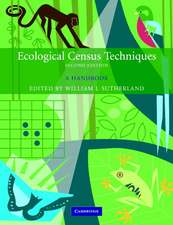Illustrated Handbook of Succulent Plants: Monocotyledons: Illustrated Handbook of Succulent Plants
S. Arroyo-Leuenberger Editat de Urs Eggli M.B. Bayer, J. Bogner, U. Eggli, P.I. Forster, D.R. Hunt, E.J.van Jaarsveld, N.L. Meyer, L.E. Newton, G.D. Rowley, G. F. Smith, J. Thiede, C.C. Walkeren Limba Engleză Paperback – 21 oct 2012
| Toate formatele și edițiile | Preț | Express |
|---|---|---|
| Paperback (1) | 1160.84 lei 39-44 zile | |
| Springer Berlin, Heidelberg – 21 oct 2012 | 1160.84 lei 39-44 zile | |
| Hardback (1) | 1874.85 lei 39-44 zile | |
| Springer Berlin, Heidelberg – 16 iul 2001 | 1874.85 lei 39-44 zile |
Preț: 1160.84 lei
Preț vechi: 1527.42 lei
-24% Nou
Puncte Express: 1741
Preț estimativ în valută:
222.12€ • 233.16$ • 184.37£
222.12€ • 233.16$ • 184.37£
Carte tipărită la comandă
Livrare economică 07-12 aprilie
Preluare comenzi: 021 569.72.76
Specificații
ISBN-13: 9783642625855
ISBN-10: 3642625851
Pagini: 404
Ilustrații: XIV, 354 p. 32 illus. in color.
Dimensiuni: 193 x 270 x 21 mm
Ediția:Softcover reprint of the original 1st ed. 2001
Editura: Springer Berlin, Heidelberg
Colecția Springer
Seria Illustrated Handbook of Succulent Plants
Locul publicării:Berlin, Heidelberg, Germany
ISBN-10: 3642625851
Pagini: 404
Ilustrații: XIV, 354 p. 32 illus. in color.
Dimensiuni: 193 x 270 x 21 mm
Ediția:Softcover reprint of the original 1st ed. 2001
Editura: Springer Berlin, Heidelberg
Colecția Springer
Seria Illustrated Handbook of Succulent Plants
Locul publicării:Berlin, Heidelberg, Germany
Public țintă
ResearchCuprins
What is a Succulent?.- How to Use This Handbook.- Scope of Information Presented.- Agavaceae ?.- Agave ? (221/50).- Beschorneria ? (7/1).- Furcraea ? (21/1).- Hesperaloe ? (5/1).- Hesperoyucca ? (1/0).- Yucca ? 47/12).- Aloaceae ?.- ?Algastoloba ~.- Aloe ? (446/57).- ?Alolirion ~.- ?Aloloba ~.- ?Alworthia ~.- Astroloba (6/0).- ?Astroworthia ? (1/0).- ?Bayerara ~.- Chortolirion ? (1/0).- ?Cummingara ~.- ?Gasteraloe ? (18/3).- ?Gasterhaworthia ~.- Gasteria ? (17/9).- ?Gastroloba ~.- Haworthia ? (62/105).- ?Maysara ~.- ?Poellneria ~.- Poellnitzia ? (1/0).- Amaryllidaceae ?.- Boophane ? (2/0).- Brunsvigia ? (2/0).- Cyrtanthus ? (4/0).- Haemanthus ? (3/0).- Rauhia ? (3/0).- Anthericaceae ?.- Chlorophytum ? (2/0).- Araceae ?.- Zamioculcas ? (1/0).- Asparagaceae ?.- Myrsiphyllum ? (3/0).- Asphodelaceae ?.- Bulbine ? (70/1).- Trachyandra ? (5/0).- Bromeliaceae ~.- Commelinaceae ?.- Aneilema ? (1/0).- Callisia ? (8/0).- Cyanotis ? (3/0).- Tradescantia ? (8/0).- Tripogandra ? (4/0).- Dioscoreaceae ?.- Dioscorea ? (6/4).- Doryanthaceae ?.- Doryanthes ? (2/0).- Dracaenaceae ?.- Cordyline ? (1/0).- Dracaena ? (7/1).- Sansevieria ? (61 /9).- Eriospermaceae ?.- Eriospermum ? (4/0).- Hyacinthaceae ?.- Albuca ? (5/0).- Bowiea ? (2/0).- Dipcadi ? (1/0).- Drimia ? (3/0).- Hyacinthus ? (1/0).- Lachenalia ? (1/0).- Ledebouria ? (3/0).- Litanthus ? (1/0).- Massonia ? (1/0).- Ornithogalum ? (10/0).- Rhadamanthus ? (8/0).- Rhodocodon ? (1/0).- Schizobasis ? (2/0).- Urginea ? (4/0).- Whiteheadia ? (1/0).- Nolinaceae ?.- Beaucarnea ? (8/0).- Calibanus ? (1/0).- Dasylirion ? (7/1).- Nolina ? (7/0).- Orchidaceae ~.- Xanthorrhoeaceae ~.- References.-Taxonomic Cross-Reference Index.
Recenzii
From the reviews of the first edition:
"This series is a reference manual for taxonomists and horticultural cognoscenti. It compiles up-to-date information not readily available from other sources … . This series is invaluable to identify succulents, by either picture keying … or by formal text keying. … The volumes are well produced. … this is an excellent series, a significant contribution to the literature, and a superb production. … This fine series is a boon to all aficionados of succulents … ." (Rudolf Schmid, Taxon, Vol. 52, 2003)
"This ‘Illustrated Handbook of Succulent Plants’ … presents the newest stand of knowledge in all aspects of this group of plants. … the cross reference index is very helpful. … this comprehensive taxonomic work updating the increased knowledge of succulents in 20 years is well suited and highly recommended to all plant scientists, including herbarium staff, and horticulturists, and to the wide range of fascinated hobbyists. … this volume will find a very wide readership … ." (Norbert Leist, Journal of Plant Physiology, Vol. 159 (7), 2002)
"Here is the first volume of the new Illustrated Handbook of Succulent Plants … . My first impression with the book in my hand was of pleasure. It is very well produced, accurately bound, with an excellent cover design. … No doubt that such a work is particularly useful to the botanist and the scholar, as well as to the serious collector. But I have no hesitation to state that any succulent plant lover should find a place for it in his library … ." (L. Russo, Botanybooks, September, 2001)
"We are promised a total of six volumes on … succulents under the title of the Illustrated Handbook of Succulent Plants. … The first of these volumes to appear is the one on monocotyledons. … this is an excellent introduction to the plant groups covered and as a rigorous compilation of both diagnostic and bibliographic information iswithout peers. … It is essential for the committed collector of succulent plants and mandatory for libraries of plant societies, herbaria and botanic gardens." (Paul I. Forster, Plant Systematics and Evolution, Vol. 229 (1-2), 2001)
"This series is a reference manual for taxonomists and horticultural cognoscenti. It compiles up-to-date information not readily available from other sources … . This series is invaluable to identify succulents, by either picture keying … or by formal text keying. … The volumes are well produced. … this is an excellent series, a significant contribution to the literature, and a superb production. … This fine series is a boon to all aficionados of succulents … ." (Rudolf Schmid, Taxon, Vol. 52, 2003)
"This ‘Illustrated Handbook of Succulent Plants’ … presents the newest stand of knowledge in all aspects of this group of plants. … the cross reference index is very helpful. … this comprehensive taxonomic work updating the increased knowledge of succulents in 20 years is well suited and highly recommended to all plant scientists, including herbarium staff, and horticulturists, and to the wide range of fascinated hobbyists. … this volume will find a very wide readership … ." (Norbert Leist, Journal of Plant Physiology, Vol. 159 (7), 2002)
"Here is the first volume of the new Illustrated Handbook of Succulent Plants … . My first impression with the book in my hand was of pleasure. It is very well produced, accurately bound, with an excellent cover design. … No doubt that such a work is particularly useful to the botanist and the scholar, as well as to the serious collector. But I have no hesitation to state that any succulent plant lover should find a place for it in his library … ." (L. Russo, Botanybooks, September, 2001)
"We are promised a total of six volumes on … succulents under the title of the Illustrated Handbook of Succulent Plants. … The first of these volumes to appear is the one on monocotyledons. … this is an excellent introduction to the plant groups covered and as a rigorous compilation of both diagnostic and bibliographic information iswithout peers. … It is essential for the committed collector of succulent plants and mandatory for libraries of plant societies, herbaria and botanic gardens." (Paul I. Forster, Plant Systematics and Evolution, Vol. 229 (1-2), 2001)
Textul de pe ultima copertă
The Illustrated Handbook of Succulent Plants represents the first comprehensive taxonomic treatment of succulents in thirty years. It covers over 9000 taxa of all succulents except Cactaceae. This up-to-date work is ideally suited for anyone interested in these fascinating plants, including hobbyists, plant scientists, horticulturalists and herbarium staff.
This volume on monocotyledons presents succulents from 17 families and 64 genera, totalling some 1100 species and over 200 infraspecific taxa. The families Agavaceae, Aloaceae and Doryanthaceae are covered in their entirety. The most important genera are Agave (century plants) with approx. 200 species, and Aloe (aloes) with about 450. Other major genera included are: Haworthia, Bulbine and Sansevieria, each with approx. 60 species. In addition, a wide variety of bulbous xerophytes from several genera are described.
This volume on monocotyledons presents succulents from 17 families and 64 genera, totalling some 1100 species and over 200 infraspecific taxa. The families Agavaceae, Aloaceae and Doryanthaceae are covered in their entirety. The most important genera are Agave (century plants) with approx. 200 species, and Aloe (aloes) with about 450. Other major genera included are: Haworthia, Bulbine and Sansevieria, each with approx. 60 species. In addition, a wide variety of bulbous xerophytes from several genera are described.
Caracteristici
First volume of the six-volume-series Illustrated Handbook of Succulent Plants, the first comprehensive treatment of succulents since 1970 Ideally suited for everyone interested in these fascinating plants - scientists, horticulturalists, hobbyists 250 brillant colour photos of monocotyledonous succulents Includes supplementary material: sn.pub/extras
Descriere
Descriere de la o altă ediție sau format:
This handbook, consisting of six volumes, covers over 9000 taxa of succulents (excluding cacti), which have the ability to store water in their stems, leaves, or underground organs.
This handbook, consisting of six volumes, covers over 9000 taxa of succulents (excluding cacti), which have the ability to store water in their stems, leaves, or underground organs.




















